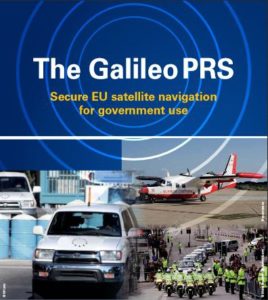Deployment of the Galileo Public Regulated Service (PRS) has been ongoing in recent years and the European GNSS Agency (GSA) has been actively contributing to the development of all user segments to ensure the widespread uptake of the service. GSA PRS Service Manager Charles Villie gave participants in the Munich Satellite Navigation Summit on March 7 a status update on the Galileo PRS and outlined plans for the future.
The Galileo PRS is an encrypted navigation service that is designed to be more resistant to jamming, involuntary interference and spoofing than other services. The launch of Galileo initial services at the end of 2016 also marked the start of the initial Galileo PRS service phase, during which receivers are being tested and all declared PRS functionalities and infrastructure are functional and operational.
Speaking at the Munich Summit, Villie said that the plan for this year is to move to the PRS enhanced service, during which pre-operational receivers will be tested. In preparation for enhanced delivery, the GSA will continue to update PRS functionalities and procedures and improve the navigation performance of PRS, which will benefit from the new satellites added to the constellation, he said.
This work is being conducted in preparation for the initial operational capability (IOC) phase, which is timed for delivery according to the European Commission Galileo roadmap. “IOC is a very important target for us, because it will be the moment when the service and the functionalities will be completely operational and the user segment will be ready to start using operational receivers,” Villie said.
He said that, ahead of IOC, the GSA is actively contributing to the development of all PRS user segments to ensure that user needs are met. This support is provided in three main axes: technical assistance to Competent PRS Authorities (CPA) in the form of workshops and training; operational demonstration and validation in PRS pilot projects and grants for joint test activities; and, finally, support for the development of user equipment, provided through Horizon 2020 and the Fundamental Elements funding mechanism.
High resilience to threats
Richard Bowden, Programme Manager at UK receiver producer QinetiQ noted at the Summit session that, as the Galileo PRS moves towards operational capacity, there is recognition of its benefits in the civil sector, but that a number of challenges remain to widespread uptake. He said that positioning, navigation, and timing (PNT) would need to be at least as good as Open Service alternatives, with substantially higher resilience to threats.
This was one of the issues addressed by Villie in his presentation. Citing encryption as the main differentiator of the PRS, Villie said that the key differences between PRS and other Galileo services are the fact PRS access is ensured by an access management policy for users, which means that continuity of service to authorised users is ensured even when access to other navigation services is denied.
“In cases of malicious or unintentional interference, the PRS increases the likelihood of continuous availability of the signal-in-space and provides an authenticated position, velocity and timing service,” he said.
High interest among users
One essential pre-requisite for the future adoption of PRS by multiple user communities is the availability of receivers for different applications. In his presentation at the Summit, Alessandro Ambri from Italian receiver producer Leonardo outlined some of the company’s main Galileo PRS receiver projects, including the GSA-funded projects P3RS-2, PRISMA, and DISPATCH.
Ambri said that his company sees the installation of Galileo PRS on its platforms as an opportunity, as it can be used in many sectors – critical infrastructure, in the military, and by emergency and security services. “We are active in all these areas and our customers have expressed an interest in the Galileo PRS,” he said.

